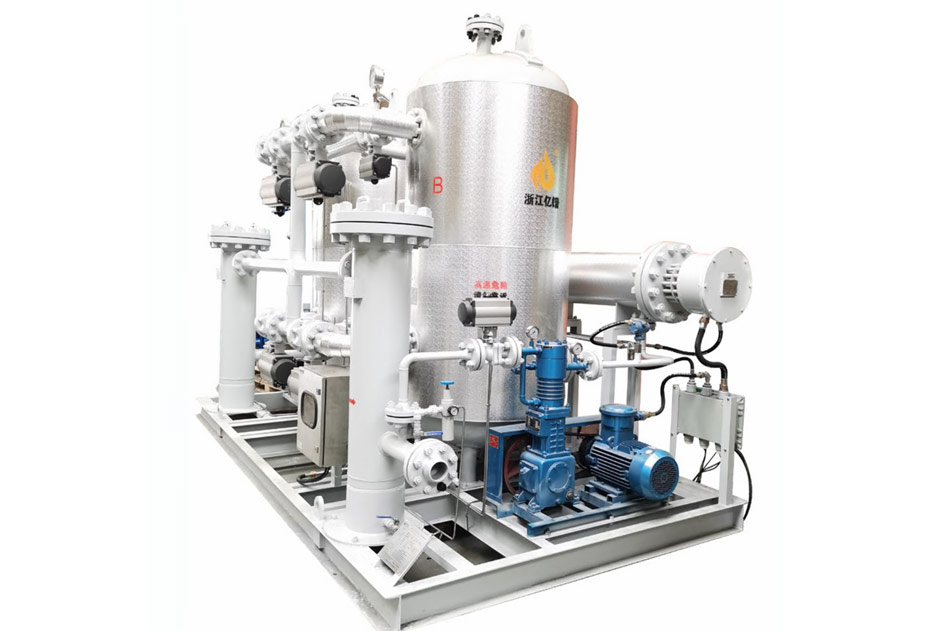Compressed Air Drying Solutions for the Oxygen Production Industry
Industry Pain Points
Ultra-Low Dew Point Requirement: Lithium-ion battery production demands compressed air with a dew point of ≤-40℃ (some processes require -70℃), which traditional refrigerated dryers (+3℃) cannot meet at all.
Zero Oil Pollution Challenge: Electrode coaters are sensitive to oil content (requiring ≤0.001ppm). Conventional adsorbents are easily poisoned by oil mist and fail within 3 months.
High Energy Consumption: Air consumption for photovoltaic silicon wafer cutting is high (over 2000Nm³/h), and the power consumption of traditional adsorption drying accounts for 25% of the total energy consumption of the production line.
Hydrogen Safety Risk: Compressed air for electrolyzers carries a hydrogen risk (≥4% LEL, Lower Explosive Limit). Existing drying equipment lacks explosion-proof design, which may easily cause combustion and explosion accidents.
System Overview
Through the “cryogenic pre-dehydration – anti-disturbance adsorption – thermal coupling regeneration” technology chain, Yipu Oxygen Production-Specific Air Drying System achieves:
- Oxygen Source Assurance: Protects oxygen-producing molecular sieves from the source, maintaining stable purity ≥99.7%.
- Energy Efficiency Benchmark: System energy consumption is 67% lower than industry standards, helping reduce comprehensive oxygen production costs.
- Intelligent Synergy: Enables full-life-cycle data interconnection with oxygen production hosts to realize predictive maintenance.
Solution Approach
Yipu Oxygen Production Industry Compressed Air Drying Solution
| Module | Technical Highlights | Performance Indicators |
|---|---|---|
| Cryogenic Refrigerated Dryer | R23/R404A cascade refrigeration, COP ≥2.5 | Pre-cooling dew point -20℃, pressure loss ≤0.01MPa |
| Anti-Pulsation Adsorption Tower | Air flow distributor + quick-opening molecular sieve loading system | Outlet dew point -70℃@0.6MPa |
| Oil Removal Reactor | Pt/Al₂O₃ catalyst, self-cleaning at 200℃ | Oil content ≤0.0005ppm, service life 5 years |
| Thermal Coupling Regeneration | Heat exchange recovery of oxygen production waste gas | Regeneration energy consumption ≤0.03kWh/Nm³, heat recovery efficiency ≥85% |
| Intelligent Interlock | Synchronized control with oxygen generator switching cycle | Dew point fluctuation ≤±3℃ |
Applicable Scenarios:
- Pre-purification for cryogenic air separation oxygen production
- Feed gas treatment for VPSA/PSA oxygen production
- Medical oxygen production lines
- Oxygen supply systems for ozone generators
Technical Principles
Yipu Three-Stage Oxygen Production-Specific Drying Process:
- Deep Condensation (Stage 1):-40℃ cascade refrigeration pre-dehydrates 40℃ saturated air, reducing its dew point to -20℃ and removing 85% of the moisture load.
- Anti-Disturbance Adsorption (Stage 2):A pulsating air flow distributor eliminates pressure fluctuations; patented 3A-OX molecular sieves achieve a dew point of -70℃ at 0.5-0.8MPa.
- Zero-Oil Assurance (Stage 3):The catalytic oxidation oil removal module decomposes residual oil into CO₂+H₂O, resulting in an outlet oil content of ≤0.0005ppm.
- Waste Heat Regeneration:Waste gas discharged from oxygen generators (80-100℃) is recycled to regenerate molecular sieves, saving 90% more energy than electric heating.
Core Advantage
| Advantage | Details |
|---|---|
| Customized on Demand | Meets special working conditions; provides professional non-standard customization |
| Low Cost | Adopts cyclic regeneration process; significantly reduces operating costs |
| High Stability | Dual-tower structure with small pressure fluctuation; low noise and continuous air supply |
| Fully Automatic Operation | Easy to operate, reducing labor input; improves efficiency |
| High Safety | Presets multi-level safety protection measures; supports automatic alarm |
| Low Failure Rate | Maintains low failure rate after 10,000 hours; high durability with almost no maintenance required |
Technical Strength
Leading Adsorption Dehydration Technology
Uses high-performance molecular sieve adsorbents with high water absorption capacity and resistance to corrosion by acidic gases (H₂S/CO₂), ensuring deep dehydration with a dew point ≤-70℃.
The original hot nitrogen regeneration process reduces energy consumption by 30% compared with traditional electric heating regeneration, and integrates a waste heat recovery system to significantly improve energy efficiency.
Modular and Customized Design Capability
Core equipment adopts modular prefabrication, supporting rapid deployment (installation cycle shortened by 50%) and adapting to diverse scenarios such as offshore platforms, onshore gas fields, and LNG pretreatment.
Can customize single-tower, dual-tower, or multi-tower parallel systems according to customer needs, with a treatment capacity ranging from 10,000 to 1,000,000 Nm³/d, flexibly matching gas fields of different scales.
Intelligent Control and Remote Operation & Maintenance
Equipped with a PLC+IoT intelligent control system, it real-time monitors key parameters such as pressure, temperature, and dew point, supporting fault early warning and automatic adjustment.
Through cloud-based big data analysis, it optimizes the adsorption-regeneration cycle, extends the service life of molecular sieves, and reduces operation and maintenance (O&M) costs by 10%-15%.
Energy-Saving and Environmental Protection Technology
Features zero-emission design for regeneration exhaust gas, complying with international environmental standards such as EU CE and US EPA.
Energy consumption is 25%-40% lower than that of traditional triethylene glycol (TEG) dehydration systems, helping customers achieve carbon emission reduction goals.
Long-Cycle Operation Reliability
Molecular sieves adopt anti-pulverization coating technology, with a service life of over 5 years, reducing replacement frequency.
Key components (e.g., valves, instruments) are selected from international first-tier brands (e.g., Siemens, Emerson), with a Mean Time Between Failures (MTBF) of over 100,000 hours.
Strong R&D and Engineering Experience
Possesses more than 19 patents and software copyrights in dehydration technology; the R&D team is led by doctors and has in-depth cooperation with universities and colleges.
Has over 1,000 successful cases worldwide, covering extreme working conditions such as high-sulfur gas fields in the Middle East and low-temperature environments in the Arctic.
Product Advantage Comparison
| Indicator | Yipu System | Traditional Refrigeration Type | Competitor Adsorption Type | Refrigeration + Adsorption Combination |
|---|---|---|---|---|
| Dew Point | -70℃ (stable) | -40℃ (fluctuation ±15℃) | -60℃ (requires frequent regeneration) | -50℃ (high energy consumption) |
| Residual Oil Content | ≤0.0005ppm | ≤0.01ppm (cumulative poisoning) | ≤0.005ppm | ≤0.001ppm |
| Energy Consumption | 0.1kWh/Nm³ (comprehensive) | 0.35kWh/Nm³ | 0.25kWh/Nm³ | 0.5kWh/Nm³ |
| Service Life of Oxygen-Producing Molecular Sieves | 5-8 years | 3-5 years | 5-7 years | 4-6 years |
| Pressure Adaptability | Seamless switching at 0.3-1.2MPa | Only 0.5-0.8MPa | 0.4-1.0MPa | Requires pressure stabilizing device |
Typical Case
Project Name: A 20,000 Nm³/h VPSA Oxygen Production Project for a Steel Enterprise
Operating Conditions:
- Treatment Capacity: 24,000 Nm³/h, pressure 0.6±0.2MPa
- Requirements: Dew point ≤-60℃, oil content ≤0.001ppm
Effect:
- Dew point stably maintained at -68℃, oil content at 0.0003ppm
- Oxygen-producing molecular sieves have been in operation for 7 years without replacement (original cycle: 2.5 years)
Economic Benefits:
- Annual electricity cost savings of 5.2 million yuan
- Reduces molecular sieve replacement cost by 8 million yuan per replacement

